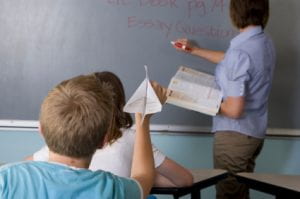Archive of ‘Adolescent’ category
 A foundational premise of student success lies in parent support and involvement at the school. Often times, parents are not involved in the educational process as much as they may like and although there are a myriad of reasons why involvement may be lacking, it is important to get parents on-board.
A foundational premise of student success lies in parent support and involvement at the school. Often times, parents are not involved in the educational process as much as they may like and although there are a myriad of reasons why involvement may be lacking, it is important to get parents on-board.
In an effort to overcome individual difference variables and events outside of a single teacher’s control, a specific communication improvement strategy that could be employed to improve the teacher-parent partnership would be to ‘touch’ parents often.
Having accessible information is excellent and providing a weekly re-cap is equally informative, however, engaging parents briefly and individually, may be the best strategy when other methods have proven unsuccessful. Taking a small moment to send a personal, positive communication note to the parent concerning their child can go a long way. This may look like:
- A “Catching Students Being Good” e-mail,
- An e-mail praising the work of a student who was successful in a challenging area; and,
- A generalized note telling the parent the teacher knows their child, knows them, and is there for both of them during the school year.
Some parents may delete these messages, which merely means the communication was not impactful to them – and that is ok. However, for some parents, it will make a world of difference in creating a true partnership between home and classroom.
Simply stated, reach out the parents; let them know their student is more than a student name and number on your roll. Invite parents into your classroom – in whatever way your district will allow you too. Allow parents to be as involved as they want in what is happening in the classroom with their children; your students.
I believe in communication equity, classroom transparency, and parent partnership. When a parent is involved, the overreaching rewards to the school, the classroom, and the student are so fruitful, it can hardly be afforded not to invest the time to foster those mutual relationships.
 In my last post Reflections on Classroom Management: Refusal in the Classroom – Part II, I reflected on the refusal in Mr. P’s class and different strategies to build relationships which may be helpful to Mr. P in turning “refusers” in to “participants”.
In my last post Reflections on Classroom Management: Refusal in the Classroom – Part II, I reflected on the refusal in Mr. P’s class and different strategies to build relationships which may be helpful to Mr. P in turning “refusers” in to “participants”.
In this third and final post, Reflections on Classroom Management: Disrespect in the Classroom – Part III, I reflect on the practice of individual focus on a singular student’s disrespectful behavior.
I begin every reflection concerning behavior with the same question “What is this student trying to communicate through this behavior?” I believe all behavior is a form of communication and decoding the communication of behavior is important.
The final scenario I reflected on concerned Mr. R. and his one disrespectful student, J.
Mr. R is a 9th grade World History teacher and he is concerned about a disrespectful student in the class. When Mr. R confronted the disrespectful student “J” about her attitude, she smirked, rolled her eyes, and muttered under her breath. The principal has made an announcement that no one should send students to the office and that all discipline problems should be handled in class. Mr. R has tried to contact J’s parents but has had no success. J continues to show disrespect daily.
Just as a teacher’s attitude and behavior can affect classroom culture, a disrespectful student can change the entire climate of the classroom; from a positive learning environment to a negative one.
This negative climate can permeate, silently undermining a positive culture, and giving other students implicit permission to be disrespectful as well. The way in which the teacher handle’s such a student is critical and can mean the difference between keeping —and losing— control of the class.
Mr. R’s difficulty with a singular student seems to require an individual solution. One such solution may be precise praise. Precise praise speaks to making positive reinforcement a strategy for the classroom while also separating mere acknowledgment from praise. Perhaps if Mr. R caught J doing something right, and came to her for the explicit purpose of positive reinforcement through praise, it would help shape J’s future behavior because the positive feedback would encourage her to continue to strive to meet Mr. R’s high expectations.
However, sometimes there is a need for critical feedback, and that feedback may be more impactful if it is delivered privately. There is power in privately delivered feedback. If the critical feedback is delivered privately, it will allow Mr. R and J to be the only ones to share in that feedback and allow any negative or embarrassing feelings to subside more quickly than if J felt she had to take defensive action for the benefit of her classmates.
J may also be more willing to correct negative behavior if she believes the privately delivered feedback was individual to her, for her, and only for her – making her feel special. However, whether the feedback is critical or positive, when the precise feedback is delivered it needs to be authentic to be memorable and genuine to be effective.
Second, Mr. R could take advantage of private feedback by perhaps establishing a set of prompts to remind J when she is exhibiting disrespectful behavior. This could help draw J back into a cooperative posture. Using a positive tone (the same tone that was hopefully delivered in the private feedback sessions) will add a bit of individuality for J when constructive feedback has to be delivered in public.
In conclusion, it is essential for a teacher not to take disruptive behavior personally. While students who are disruptive in the class have many motivations, rarely are those motivations malicious or its roots against the teacher personally. In other words, the teacher could be anyone if identical internal, external, and environmental factors remained constant.
The ability to stay calm, be polite, and treat even the most trying and disruptive of students with respect are necessary tools for every educator’s tool kit. Listen to what the disruptive students have to say and know that behavior is a form of communication.
 I read an interesting article yesterday about fact-checking. The article by Sam Wineberg (2015) entitled Why Historical Thinking is Not about History reiterated a point we need to drive home to our students, information needs to be verified — this is especially true about information found on the internet.
I read an interesting article yesterday about fact-checking. The article by Sam Wineberg (2015) entitled Why Historical Thinking is Not about History reiterated a point we need to drive home to our students, information needs to be verified — this is especially true about information found on the internet.
Wineberg talks about a Virginia textbook author who included unverified information from the internet in her 4thgrade Virginia history textbook. He also mentions a group of California teachers who inadvertently convinced some students that the Holocaust was ‘propaganda’ and a ‘hoax’ by providing the students comparative information retrieved from the internet as a sole source.
As Wienberg says, “The Internet has obliterated authority” (p. 14) and everyone and anyone can fall victim to easy information. Easy information, which is free floating, a top Google search result, not cited, etc. is easy to grab, absorb, and retell as fact. But we need to be careful about the redistribution of internet information and teach our students to examine sources critically.
To this point, Wienberg (2015) speaks of the need to train everyone to think like a historian in order to avoid such conundrums of information overload in the digital age. We can do this by equipping students with the skills to think like historians. By having students investigate primary sources, dig deep into the origins of information, and act with civic intelligence we will help students filter out the noise and focus on true and valid information.
A dense social studies education both implicitly and explicitly provides this foundational dexterity. This digital citizenship will help students through the informed decision-making process and perhaps even take the confusion (and argument) out of sifting through the copious amounts of information found on the internet.
In the end, training students to think like a historian will train them to make decisions through the lens of critical examination — for all information presented throughout their lives. From reading the newspaper and social media posts to making decisions regarding finances and career; when a student is able to ferret out accurate information they are able to make informed decisions. It is our job as educators to teach students the application of skills to be successful in life’s endeavors.
 As the nation has evolved and industrialized, the need for a social studies education remains critical. The original design of promoting civic competence is still foundational; however, this multidisciplinary field interweaves history, political science, economics, and geography to create a unique platform for integrated study.
As the nation has evolved and industrialized, the need for a social studies education remains critical. The original design of promoting civic competence is still foundational; however, this multidisciplinary field interweaves history, political science, economics, and geography to create a unique platform for integrated study.
The discipline takes a more holistic view today than ever before as social studies today concerns itself with academic rigor, data collection, analysis of facts, the collaboration of thought, and strong decision-making and problem-solving skills in addition to its historical goals. However, to keep students engaged in social studies as a discipline, maintaining traditional pedagogical survey approaches may not be the best option.
The emergence of the inquiry method has been significant in the ever-evolving understanding of ‘social studies’ because human inquiries, general arguments, holistic assumptions, and individual points of view are at the heart of what makes social studies a profound and rewarding scholarship.
Simply regurgitating facts is not studying social studies; it is memorizing facts which will soon be forgotten. This type of study is akin to the “attic” philosophy, which postulates that memorization is like storing information in one’s brain in the same way one may store furniture in an attic. Indeed, this may not be the best approach when seeking to create a historical thinking framework.
However, when students learn through the lens of various inquiries, such as visual inquiry, critical inquiry, and moral inquiry, historical thinking becomes more relevant, more applicable, and converts to process rather than function.
Inquiry leads students through discussion. Teachers don’t act as an authority on the topic but allow the relevant questions to become opportunities for students and teachers to do history themselves, to encounter the past in all its messy, uncertain, and elusive wonder.
Although it is realistic to assume that all students won’t become historians and that all students will not necessarily reach the level of trained historical thinking with which professional historians work their craft, students need to find ways to execute the basic steps of inquiry which develop a historical mindedness.
Specifically, by learning cognitive habits, such as questioning, connecting, sourcing, making inferences, considering alternate perspectives, and recognizing limits to personal knowledge, students create habits students to carry with them not only to other classes but into the workplace.
Further, such cognitive habits will ideally become invaluable to students as they navigate the constant bombardment of information. Developing these skills will aid students in navigating the shoals of unreliable/solid, false/true, dependable, and rickety information which floods society every day. When a student has a substantial social studies education, steeped in inquiry they are more prepared for sifting the wheat from the chaff.
 In my last post Reflections on Classroom Management: Emotional Consistency and Classroom Management – Part I, I reflected on the disruptive behavior in Ms. S’s class and how a self-inventory regarding emotional consistency may be helpful to Ms. S in turning around the classroom culture.
In my last post Reflections on Classroom Management: Emotional Consistency and Classroom Management – Part I, I reflected on the disruptive behavior in Ms. S’s class and how a self-inventory regarding emotional consistency may be helpful to Ms. S in turning around the classroom culture.
In this second post Reflections on Classroom Management: Refusal in the Classroom – Part II, I reflect on the practice of meeting student’s where they are and understanding refusal.
I begin every reflection concerning behavior with the same question “What is this student trying to communicate through this behavior?” I believe all behavior is a form of communication and decoding the communication of behavior is important.
The second scenario I reflected on concerned Mr. P. and his story about “refusal.”
Mr. P is a physical education teacher and he is concerned about five students in one of his physical education class who refuse to dress out. Despite several consequences:
- Taking points away from their averages,
- Contacting parents,
- Sending them to a study hall classroom instead of gym class; and,
- Having the “refusal” students ‘run laps’ in their regular school dress.
the students continue not dressing out. While the majority of the students are participating appropriately, these five “refusers” remain on the sidelines of the activity teasing and tormenting each other as well as others.
When groups of students refuse to follow directions provided by the teacher it can be distressing. Somewhere between an entire class and a single student, there are the small groups of students who, when band together, create an undeniable disruption in the learning environment. When the entire class is not at issue, strategies to effectively manage disruptive behavior may need to be broken down.
To change the behavior and culture of the disruptive five “refusers,” Mr. P may take certain steps, such as:
- Explaining to the five “refusers” exactly what is expected of them when they are asked to dress out,
- Work on building positive relationships with the refusal group as a whole and perhaps the most influential student of the refusal group
- Work on building positive relationships with individual members of the refusal group,
- Provide the five “refusers” with a choice of activity for gym to promote gym buy-in and encourage them to dress out for something they want to do versus something they have to do,
- Verbalize consequences for behaviors which are not appropriate to force the students to share responsibility among themselves for “refusal” behaviors; and,
- Specifically reinforcing the progress and effort individually for each of the five “refusers” as well as the five “refusers” as a group will help cement a successful behavior and attitude change.
Mr. P may also benefit by proving these particular students with a challenge. Providing a challenge or healthy competition for these five “refusers”, may entice these students to participate through the innate drive of competition.
While this strategy is similar to allowing the students to choose their own activities, healthy competition creates an activity not only for the five “refusers” but for the rest of the students as well — possibly creating whole class gym buy-in. Whether these five “refusers” compete against each other or the whole class, creating something that is different from the usual gym class will allow the five “refusers” to channel the negative energy of refusal positively.
 I recently reflected on the practice of setting and maintaining high behavioral expectations in the classroom. I spent some time reflecting on these concepts through the specific lens of producing responsible behavior in the classroom.
I recently reflected on the practice of setting and maintaining high behavioral expectations in the classroom. I spent some time reflecting on these concepts through the specific lens of producing responsible behavior in the classroom.
This reflection was prompted after listening in on a few conversations being had by veteran teachers. After listening to several conversations I began to reflect on my approach to handling those behaviors now that I have more than an academic understanding of classroom management.
I seem to begin every reflection concerning behavior with the same question “What is this student trying to communicate through this behavior?” I believe all behavior is a form of communication and decoding the communication of behavior is important. Students are crafty, and they know how to get, or get out of, something by ‘behaving’ in a certain manner (the function of behavior).
The first scenario I reflected on encompassed a classroom narrative by “Ms. S”.
Ms. S has an extremely disruptive class and she is both frustrated and concerned about the students’ classroom behavior. Ms. S has employed a rewards system and tried to follow through with consequences for bad behavior, but the students are still disruptive. Ms. S often becomes so frustrated with the student’s behavior that she admits to sometimes ‘losing her cool’ by yelling at the students. Ms. S has even gone so far as to drop a book on the floor because she thought the loud noise would get the students attention.
Disruptive behavior in Ms. S’s classroom looks like the student’s:
- Calling out
- Leaving their seats,
- Talking with other students during instructional time
- Making inappropriate comments both to the teacher and to other students
- Not following directions
Ms. S has tried such consequences as:
- Writing students’ names on the board for talking after several warnings,
- Threatening to contact parents for disruptive behavior,
- Threatening to ‘write-up’ students for not following directions,
- Detention for students throwing objects or not complying with instruction; and,
- The removal of a student’s desk from the class for making faces and causing other students to laugh.
Ms. S has even gone so far as to hold students after the dismissal bell because she had not verbally dismissed the class and when the students began to leave regardless of her verbal commands to remain seated, she physically blocked the student’s egress.
Disruptive behavior can adversely affect the classroom environment and negatively affect the learning experience of students. Although it is ideal to prevent disruptive behavior before it begins, there are times when active measures must be taken once disobedience has become classroom culture.
Since Ms. S’s classroom exhibits almost every disruptive behavior imaginable and from all students, it can easily be assumed that Ms. S is frustrated, tired, and discouraged regarding her student’s classroom behavior—it can also be easily assumed that her students know this.
To change this classroom culture, Ms. S’s first action needs to be an evaluation of herself. Taking inventory of your own emotional consistency as a teacher is important. When a teacher consistently manages his or her emotions it encourages student learning and achievement by creating a safe environment of calm and learning. Since teachers are the leaders of classroom culture, the teacher’s emotions dictate classroom culture.
There are several strategies to help a teacher maintain emotional consistency in the classroom:
- Walk slowly towards the problem situation to give a moment or two to regain composure before addressing the problem,
- Ensure that the words used in a problem situation condemn the behavior, not people,
- Make sure to take the relationship out of any corrective action;
- Be conscious and cautious of tone and non-verbal signals; and,
- Avoid globalizing the problem situation or behavior.
It is important to avoid showing the students that their behaviors have flustered the teacher in any way. While easier said than done, when a close read of one’s own behavior is done, the results can inspire meaningful behavior change for the individual as well as meaningful classroom cultural change.
 Promoting a learning environment steeped in respect, scholarship, and accountability requires the classroom to possess a certain cultural competence. Like with all competencies, students arrive to the classroom at different places. Just as we differentiate for content, we too must differentiate for cultural competence with the goal of getting students on the same page.
Promoting a learning environment steeped in respect, scholarship, and accountability requires the classroom to possess a certain cultural competence. Like with all competencies, students arrive to the classroom at different places. Just as we differentiate for content, we too must differentiate for cultural competence with the goal of getting students on the same page.
This is especially important as secondary school focuses more on collaborative learning as an instructional method. Collaborative learning activities require students to have an open mind, a healthy respect for others who hold both similar and opposing opinions, as well as for students to feel safe enough to express thoughts, viewpoints, beliefs, and ideas in the classroom.
However, what happens when the collaborative group has different opinions? Often conflict erupts and needs to be quelled. While conflict management and conflict resolution are often used interchangeably, they are not the same thing. Conflict management generally refers to an individual’s conflict “style” or their reaction to conflict while conflict resolution utilizes the skills employed to resolve a conflict.
I mention this distinction because when classroom disagreements between students arise, the student behaviors are typically conflict management behaviors and the teacher behaviors are typically conflict resolution behaviors. Understanding this concept as a teacher allows you to help your students learn to operate in an environment of productive — respectful disagreement.
I assure you from personal experience, as someone who use to do mediation work for the EEOC in Atlanta, that respectful disagreement is rare. It is so critical to teach students to agree to disagree, focus on the problem, not the person, and not to personalize uncomfortable feelings. It is easy to get caught up in disagreements over values, judgments, and beliefs; especially ones held close. It is vital to teach young people how to navigate those disagreements, and sometimes the cognitive dissonance that goes along with disagreements over such personal issues, with mutual respect.
In the end, conflict is merely the inability to communicate effectively, tolerate differences of opinion, and a strong penchant for personalizing the problem – making the person the target of the conflict, not the problem. These deficits create intractable positions and an “us” versus “them” mentality, making conflict resolution virtually impossible.
This is why I believe that fostering communication, a safe space for disagreement, and a culture of openness and tolerance in the classroom is so important. If students learn to manage their emotions in the face of differing opinions as well as learn to pay attention to the feelings (not just the words spoken) of the other person, they will be much more able to manage conflict stress, while remaining calm and moving towards amicable solutions to problems; even if the solution is agree to disagree. If students are taught these skills early, they will most certainly carry this skill set into their adult lives, and perhaps there will be fewer cases to settle at the EEOC.
 We’ve all been here—the argument with your adolescent. The conflict is exhausting and the battle hardly seems worth it—then one of you makes the comment “Just never mind; I won’t say anything else about (insert subject here).”
We’ve all been here—the argument with your adolescent. The conflict is exhausting and the battle hardly seems worth it—then one of you makes the comment “Just never mind; I won’t say anything else about (insert subject here).”
Whether said in frustration, disgust, or in earnest—most people are true to their word; they say nothing else. But some ruminate. They stew. They mull it over, turning the subject, conversation, and action surrounding the conflict over and over in their minds—keeping it fresh.
This type of “chewing over” of a subject keeps the “instant replay reel” active long after the conflict has subsided. That’s because for some, switching gears is a task that proves unmanageable, can look like an inability to “move-on,” and can actively sabotage healing and understanding.
What happens when you love someone who ruminates and won’t let “it” go? What happens when the constant references to the “thing” they were never going to speak of again, can no longer go unnoticed? What happens when the body language, facial expressions, and side comments are relentless? What happens when the obsession and hyper-focus on the subject of conflict causes rifts in a relationship?
What happens? Resentment, ill-will, bitterness, and disengagement from the person is what typically happens. Although reasons for hanging on are as individual as the person themselves, resolution can be more universal.
First, it is important to change the way we think about conflict. Conflict is healthy, can be respectful, and a way to grow with—not apart from—your adolescent. True adolescent conflict typically surrounds issues of autonomy and it is why this type of conflict can be so transformative, bringing to the table a level of understanding not previously known.
Second, it is always important to stop when the conflict is becoming unproductive. Getting stuck in cyclical disputes heightens emotions and makes positions intractable. As hard as it may be to disengage, do it. A physical reset will change the dynamic, perspective, and possibly preserve feelings. While vocalizing that you need to take a break and taking it is beneficial, making the same vocalization and storming off, slamming doors, or muttering just loud enough for the other person to hear as you walk away is not helpful. Reset time is for disengagement, to recompose, and then reengage—not get the last word.
Third, don’t be afraid to ask the question. While many disengage from conflict agreeing to disagree, some continue to hold the baggage and continue to damage the relationship. For those with intractable positions, simple questions like, “Is something still bothering you?”, “Do you want to talk?” or “Do you know why you’re still upset about this?” can go a long way in getting to the root of disagreement. If the questions are answered, it is not unusual to hear the words “everybody,” “always,” and “never.” Get clear about this. Who is everybody, when is always, and what is never? Shrink the broad circle to a smaller more manageable ring.
Fourth, for both the parent and the adolescent—do what you say you are going to do. If the conflict ends and you aren’t over it, don’t commit to letting it go. Instead, commit to engage in helpful and healthy conversation. If the conflict ends and you are over it, acknowledge that and move on.
In the end, viewing conflict through an adolescent lens of independence can help re-frame the fight. While conflict is a fact of life, how we engage, manage, transform, and disengage is ultimately a choice. By letting go of the conflict and not ruminating—the parent-adolescent relationship can grow stronger and evolve along its natural continuum into a strong, healthy, and supportive parent-adult child relationship.

Adolescence is a time when young people begin to care greatly about their appearance—how they see themselves and how others see them. They begin to question their appearance—will it help or hinder social and romantic relationships? These thoughts lead to questions of “Am I too _______?”, “I am not _______.”, or “I wish I was _______!”
Although this is not a new phenomenon, the modern adolescent has to contend with the bombardment of media in everyday life. Media is now woven through the tapestry of adolescence. Countless media sources send messages about body image, and much attention has been given to media, in all of its forms, for promoting the idea that “thin is beautiful” or that you have to “look a certain way” to be popular, smart, or get a date.
The most important message: The media’s job is to promote perfection by using images as a barometer. Their job is to create a perfect person, which does not exist, so that an advertiser’s product will be purchased by a consumer who hopes to transform themselves into a perfect person. The media is an illusion and should be viewed through the lens of the fantasy it was hired by advertisers to create.
Now that we’ve gotten that out of the way……………… the rest of the message comes by understanding puberty and some of the effects not talked about in standard family life classes.
Body dissatisfaction and the ill effects it can produce have the most negative impact on young girls as they enter puberty. In fact, “Only about one fourth (26.7%) of American adolescents are highly satisfied with their body.”[1] That means three out of every four (73.3%) adolescent girls you meet is at risk for some sort of unhealthy habit, thought, or pattern surrounding their body and this usually translates into unhealthy food and eating habits.
Although less than 1% of female adolescents are anorexic and only about 4% bulimic, these are just the reported statistics. I can say that I attended a middle school filled with closet bingeing and purging and it is unlikely they would have admitted the behavior. It was even an accepted practice in many movies of my middle school and early high school generation. Of course, I’m showing my age in that respect, but from what I see on my own social media and the social media of those teens I do know—body image is still a hot topic. A topic still misunderstood, still unhealthy, and still needing serious conversations. Mixed messages sent by the media, parents, peers, and other role models can lead to a lifelong unhealthy relationship with food at best and body dysmorphia at worst.
It’s important to talk to adolescents about healthy food choices and exercise, not “controlling” weight (or image). Openly discuss issues surrounding body dissatisfaction and don’t discount concerns as adolescent angst, irrational comments, dramatic play, or comparison syndrome. The thoughts and feelings adolescents have about their body, especially in middle school, are seared into their fiber and become a part of who they will become as an adult—good, bad, or indifferent.

My son, as a newborn, was the sleeping envy of all new mothers—this was because he slept. As a toddler, there were no bedtime showdowns. Even through the different stages of elementary school, he went to bed at night and awoke in the morning without protest. But something happened to this child shortly after his eleventh birthday; he seemed to have acquired an inability to get out of the bed in the mornings for school.
As this pattern emerged, the morning family routine became increasingly dysfunctional. There were arguments, hurt feelings, and lots of breakfasts crammed in at the bus stop. By week three of school, I began to worry. Not only had he started middle school, but he started a new middle school—far away from home and with kids he had never met. I wondered if I had made the wrong choice—if this were just a silent protest to his new situation. I talked to him, I listened to him, I interrogated him, and……I believed him—it wasn’t school.
His side of the story: He’s tired, he tries to get out of bed, and there is no understanding on the part of his stepfather how tired he is. He simply can’t get out of bed—his body won’t let him.
My side of the story: If you are tired go to bed earlier, I’m tired too, and I do understand—I understand that getting out of bed is essential to making it to school on time. I get out of bed, my body lets me, and I’m old.
Clearly, we were at a sleep-wake impasse. Then, I came across some interesting research related to puberty and changes in patterns of sleep. I read about something called delayed phase preference (DPP), a sleep pattern characterized by later sleep-wake times.
Here’s what I learned:
- DPP is driven by the biological changes of puberty,
- Melatonin plays a sizable role in DPP,
- Environmental factors contribute to DPP,
- Adolescents are most alert after 3pm and least alert between 8am–9am,
- Different sleep-wake times on weekends vs. weekdays makes the problem worse, and
- DPP usually begins to reverse around age twenty.
It is well know that melatonin plays a considerable role in our sleep-wake pattern. When melatonin levels rise (usually in the evenings), we feel sleepier, and when melatonin levels fall (usually in the mornings), we feel more awake. But the secretion of melatonin means something more for adolescents. The secretion of melatonin plays a role (along with kisspeptin and other hormones) in triggering puberty.
During puberty, the time of night the body releases melatonin changes. As physical maturation progresses, the changes become later and later. In fact, for those adolescents who have completed puberty, the body releases melatonin an average of two hours later than for those who have not yet completed puberty—resulting in the need to stay awake up to two hours later than those who have not yet, or have just started, puberty.
This holistic shift in the melatonin release cycle is fascinating, but unfortunately, the combination of biologically-induced late sleep times and rigid early school wake times cause problems for adolescents—namely sleep deprivation and daytime sleepiness. Sleep deprivation and daytime sleepiness can cause cognitive impairment, poor school performance, poor self-control, obesity, accidents, and even depression, just to name a few. Compounding this problem—the amount of sleep an adolescent requires is still around nine hours a night.
DPP explained exactly what had begun to happen with my usually-easy-sleeping and early-rising child. As I reflected, there was a pattern emerging, of not only difficulty in waking but also a preference for keeping later hours in the evening. Once I understood it was driven by biological factors and not the beginnings of the argumentative stage of boundary-testing autonomy, I began to make adjustments.
1. The family routine became priority number one. Sticking to roughly the same sleep-wake cycle every day—even on weekends. Even on those evenings when sleep is elusive, just lying in bed and “resting” your body is supportive.
2. We began preparing for the next morning the night before, allowing him to squeeze the last bit of sleep from the snooze button. Things such as packing book bags, sports bags, and lunches, as well as taking showers and laying out clothes for the next day.
3. When the sun goes down, the lights—and the devices—go off.
4. Occasionally supplementing melatonin is not out of the question.
All of these adjustments have been time—and sanity—savers. They have also helped honor this DPP biological time of life. Although I have no control over school start times, I can make easing into sleep and transitioning to morning easier for him, as these biological changes are just a part of growing up.
 A foundational premise of student success lies in parent support and involvement at the school. Often times, parents are not involved in the educational process as much as they may like and although there are a myriad of reasons why involvement may be lacking, it is important to get parents on-board.
A foundational premise of student success lies in parent support and involvement at the school. Often times, parents are not involved in the educational process as much as they may like and although there are a myriad of reasons why involvement may be lacking, it is important to get parents on-board. In my last post Reflections on Classroom Management: Refusal in the Classroom – Part II, I reflected on the refusal in Mr. P’s class and different strategies to build relationships which may be helpful to Mr. P in turning “refusers” in to “participants”.
In my last post Reflections on Classroom Management: Refusal in the Classroom – Part II, I reflected on the refusal in Mr. P’s class and different strategies to build relationships which may be helpful to Mr. P in turning “refusers” in to “participants”. I read an interesting article yesterday about fact-checking. The article by Sam Wineberg (2015) entitled Why Historical Thinking is Not about History reiterated a point we need to drive home to our students, information needs to be verified — this is especially true about information found on the internet.
I read an interesting article yesterday about fact-checking. The article by Sam Wineberg (2015) entitled Why Historical Thinking is Not about History reiterated a point we need to drive home to our students, information needs to be verified — this is especially true about information found on the internet. As the nation has evolved and industrialized, the need for a social studies education remains critical. The original design of promoting civic competence is still foundational; however, this multidisciplinary field interweaves history, political science, economics, and geography to create a unique platform for integrated study.
As the nation has evolved and industrialized, the need for a social studies education remains critical. The original design of promoting civic competence is still foundational; however, this multidisciplinary field interweaves history, political science, economics, and geography to create a unique platform for integrated study. In my last post Reflections on Classroom Management: Emotional Consistency and Classroom Management – Part I, I reflected on the disruptive behavior in Ms. S’s class and how a self-inventory regarding emotional consistency may be helpful to Ms. S in turning around the classroom culture.
In my last post Reflections on Classroom Management: Emotional Consistency and Classroom Management – Part I, I reflected on the disruptive behavior in Ms. S’s class and how a self-inventory regarding emotional consistency may be helpful to Ms. S in turning around the classroom culture. I recently reflected on the practice of setting and maintaining high behavioral expectations in the classroom. I spent some time reflecting on these concepts through the specific lens of producing responsible behavior in the classroom.
I recently reflected on the practice of setting and maintaining high behavioral expectations in the classroom. I spent some time reflecting on these concepts through the specific lens of producing responsible behavior in the classroom. Promoting a learning environment steeped in respect, scholarship, and accountability requires the classroom to possess a certain cultural competence. Like with all competencies, students arrive to the classroom at different places. Just as we differentiate for content, we too must differentiate for cultural competence with the goal of getting students on the same page.
Promoting a learning environment steeped in respect, scholarship, and accountability requires the classroom to possess a certain cultural competence. Like with all competencies, students arrive to the classroom at different places. Just as we differentiate for content, we too must differentiate for cultural competence with the goal of getting students on the same page. We’ve all been here—the argument with your adolescent. The conflict is exhausting and the battle hardly seems worth it—then one of you makes the comment “Just never mind; I won’t say anything else about (insert subject here).”
We’ve all been here—the argument with your adolescent. The conflict is exhausting and the battle hardly seems worth it—then one of you makes the comment “Just never mind; I won’t say anything else about (insert subject here).”
